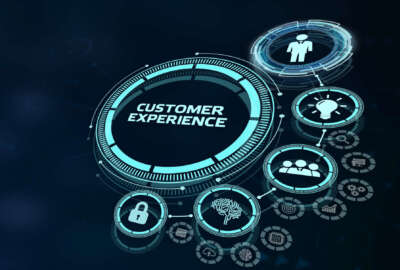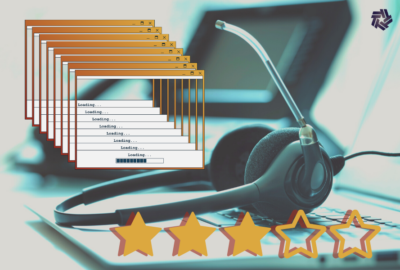Insight by Okta
Agencies working together on shared CX goals for simple, seamless secure services
Okta’s LaRel Rogers tells Federal News Network that federal agencies are holding themselves to a higher standard for better customer experience online.
Agencies are holding themselves to a higher standard for better customer experience online, and working together on projects that will lead to across-the-board improvements in CX across the federal government.
LaRel Rogers, the senior product marketing manager for federal at Okta, said the government is under increasing pressure to provide a digital-first and intuitive customer experience. That’s to meet a high bar set by private-sector companies.
“If you and I were just having a casual conversation, and I brought up Uber Eats and Airbnb in the same conversation, you wouldn’t bat an eye. That’s not because those two companies have an overlap in their mission, but because they have an overlap in the way that they deliver their service,” Rogers said.
In government, High-Impact Service Providers such as Recreation.gov and the Labor Department’s Employment Training Administration are making improvements in service delivery that will benefit large swaths of the public.
Their missions, however, vary considerably. Recreation.gov is trying to give the public a user-friendly way to apply for whitewater rafting permits in national parks, while ETA is looking to aggregate data from the public and private sectors to create a unified job board for individuals.
“Those are two different agencies, two different missions, but from the service delivery, we’re looking at that overlap,” Rogers said.
Under the Biden administration’s customer experience executive order, agencies are collaborating on cross-government customer experience projects. More than half a dozen agencies, for example, are working together on ways to enroll eligible families of young children into federal programs.
Having a child is just one of five “life experiences” that are a focus of the Biden administration’s work on improved public-facing government services.
“I did not know that there are six different agencies that you would have to rely and depend on when you’re having a child. So that’s what government is doing,” Rogers said. “They’re taking the guesswork from you and having just a one-stop shop — ‘You’re having this really critical moment in your life and time, and we’re here to help you during that.’”
The Biden administration is also taking steps to cut down the “time tax,” or the loss of time an applicant experiences when trying to obtain a government service or benefit. Rogers said the “time tax” to obtain public-facing services may disproportionately impact certain demographics.
“If you are a mom, and you have to take time off work, the average American does not have unlimited paid time off. They may not even have paid time off. So, they have to take off work with potentially losing out on income. Then it’s the decision of whether or not do they have to find appropriate child care. They have to maybe find reliable transportation. They may actually get to the agency, and forgot an important document or a document they didn’t realize that they needed. That’s all summarizing a huge burden that’s on the mother in that that situation,” Rogers said.
To reduce the burden on taxpayers, WIC is piloting, in some states, the ability for individuals to receive their Special Supplemental Nutrition Program for Women, Infants, and Children (WIC) benefits online, as well as shop for groceries online.
The Social Security Administration is also piloting the ability for individuals to change their last name online.
“Instead of having to go in person, you can change your name online, which really goes back to ‘rebuild trust,’ those last two words in the customer experience order. It’s allowing the public to refresh and update the information on their own time and in their own way,” Rogers said.
To make government services more accessible to more people, agencies are taking steps to improve their level of service over the phone, in-person and online — as well as across all devices.
Rogers said the Education Department, for example, is taking steps to make it easier for students to apply for Free Application for Federal Student Aid (FAFSA) across multiple devices.
“They may start that FAFSA application on their mobile phone, go throughout their day, go to school, and then wait for their parents to come home and then want to pick that back up. They don’t want to have to start over,” Rogers said. “They might be doing that application on a different device. It could be their parent’s phone, it could be their parent’s tablet or desktop. There has to be a level of security factored in.”
Rogers said agencies are also taking steps to make these online services seamless for users through “secure by design.” Simple, but effective security steps include phishing-resistant multi-factor authentication.
“In situations where that student is starting their application, and the device context gives you that they’re starting it in Baltimore, Maryland. And then later that night, it sees that they’re picking it back up on a different device that’s located in San Francisco, California. That might be a red flag,” Rogers said. It’s not to say that’s impossible, but there are ways, at least for identity and access management on the backend, that you can flag that you can either log that person out, or you can ask for step-up phishing-resistant MFA,” such as facial recognition or some other biometric.
Discover more about how to elevate your customer experience in the “Excellent, equitable and secure customer experience: A closer look at high-impact service providers” series.
Copyright © 2024 Federal News Network. All rights reserved. This website is not intended for users located within the European Economic Area.
Jory Heckman is a reporter at Federal News Network covering U.S. Postal Service, IRS, big data and technology issues.
Follow @jheckmanWFED






